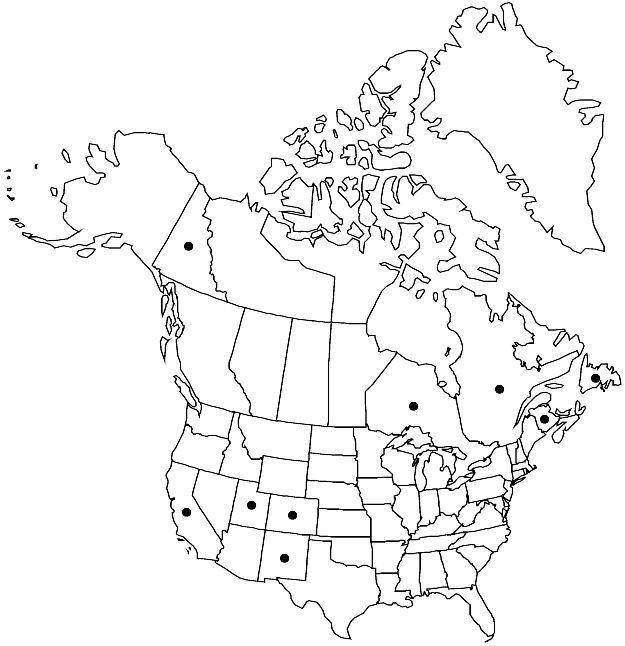Difference between revisions of "Brachythecium salebrosum"
in P. Bruch and W. P. Schimper, Bryol. Europ. 6: 20. 1853.
FNA>Volume Importer |
imported>Volume Importer |
||
| (3 intermediate revisions by 2 users not shown) | |||
| Line 1: | Line 1: | ||
{{Treatment/ID | {{Treatment/ID | ||
|accepted_name=Brachythecium salebrosum | |accepted_name=Brachythecium salebrosum | ||
| − | |accepted_authority=(Hoffmann ex F. Weber & D. Mohr) | + | |accepted_authority=(Hoffmann ex F. Weber & D. Mohr) Schimper |
|publications={{Treatment/Publication | |publications={{Treatment/Publication | ||
|title=in P. Bruch and W. P. Schimper, Bryol. Europ. | |title=in P. Bruch and W. P. Schimper, Bryol. Europ. | ||
| Line 10: | Line 10: | ||
|name=Hypnum salebrosum | |name=Hypnum salebrosum | ||
|authority=Hoffmann ex F. Weber & D. Mohr | |authority=Hoffmann ex F. Weber & D. Mohr | ||
| + | |rank=species | ||
|publication_title=Bot. Taschenbuch, | |publication_title=Bot. Taschenbuch, | ||
|publication_place=312. 1807 | |publication_place=312. 1807 | ||
| Line 16: | Line 17: | ||
|name=Brachythecium flexicaule | |name=Brachythecium flexicaule | ||
|authority=Renauld & Cardot | |authority=Renauld & Cardot | ||
| + | |rank=species | ||
}} | }} | ||
|hierarchy=Brachytheciaceae;Brachythecium;Brachythecium salebrosum | |hierarchy=Brachytheciaceae;Brachythecium;Brachythecium salebrosum | ||
| Line 39: | Line 41: | ||
-->{{#Taxon: | -->{{#Taxon: | ||
name=Brachythecium salebrosum | name=Brachythecium salebrosum | ||
| − | + | |authority=(Hoffmann ex F. Weber & D. Mohr) Schimper | |
| − | |authority=(Hoffmann ex F. Weber & D. Mohr) | ||
|rank=species | |rank=species | ||
|parent rank=genus | |parent rank=genus | ||
| Line 53: | Line 54: | ||
|publication year=1853 | |publication year=1853 | ||
|special status= | |special status= | ||
| − | |source xml=https:// | + | |source xml=https://bitbucket.org/aafc-mbb/fna-data-curation/src/2e0870ddd59836b60bcf96646a41e87ea5a5943a/coarse_grained_fna_xml/V28/V28_661.xml |
|genus=Brachythecium | |genus=Brachythecium | ||
|species=Brachythecium salebrosum | |species=Brachythecium salebrosum | ||
Latest revision as of 21:37, 5 November 2020
Plants medium-sized to large, in moderately dense mats, green, yellowish, brownish, or brownish yellow. Stems to 8 cm, creeping, terete-foliate, irregularly or often regularly pinnate, branches to 8 mm, straight to slightly curved, terete- to subcomplanate-foliate. Stem leaves erect to erect-spreading, loosely imbricate to somewhat spaced, ovate-lanceolate, lanceolate, or narrowly ovate-triangular, broadest at 1/10–1/7 leaf length, slightly concave, plicate, 1.7–2.6 × 0.6–1 mm; base shortly rounded, narrowly short-decurrent; margins plane or recurved at places, serrulate to serrate; apex gradually tapered or long-acuminate; costa to 60–75% leaf length, strong, terminal spine present; alar cells subquadrate to short-rectangular, same size as or smaller than basal cells, 12–20 × 10–13 µm, walls moderately thick, region clearly delimited, of 3–6 × 3–5 cells; laminal cells linear, 40–100 × 6–9 µm; basal cells to 10–12 µm wide, region in 1 or 2 rows, not markedly different from more distal cells. Branch leaves with basal laminal cells enlarged across base. Sexual condition autoicous. Seta orange-brown to dark brown, 1–2 cm, smooth. Capsule horizontal, brown to dark brown, elongate, curved, 2 mm; annulus separating by fragments; operculum long-conic. Spores 13–17 µm.
Habitat: Soil, rock, tree bases, rotten logs, exposed to shady habitats
Elevation: low to moderate elevations (0-1500 m)
Distribution

N.B., Nfld. and Labr. (Nfld.), Ont., Que., Yukon, Calif., Colo., N.Mex., Utah, Eurasia, n Africa, Australia.
Discussion
Brachythecium salebrosum was considered widespread in North America, but a revision of herbarium collections from eastern North America demonstrated mostly B. acutum, B. campestre, B. rotaeanum, and marginal phenotypes of B. laetum among these. However, plants of B. salebrosum that are identical with European plants occur in western North America and in eastern Canada. Brachythecium salebrosum is characterized by slightly falcate, plicate, and lanceolate leaves, rather distinctly serrulate leaf margins, narrow laminal cells almost reaching the leaf base near the costa, and a small quadrate alar region composed of subquadrate cells. Brachythecium salebrosum is autoicous, and this distinguishes it from B. laetum. Brachythecium rotaeanum has erect-appressed and usually not falcate leaves and a basal areolation that is more homogeneous, without a clear angular group and with rather lax areolation in the basal juxtacostal area. Brachythecium acutum has a lax and even basal areolation and gradually tapering leaves that are rarely falcate-secund. Sterile plants of B. campestre are difficult to separate from B. salebrosum as the most important character for delimitation is the rough seta in the former species. Well-developed sterile plants of B. campestre can be distinguished by the broadening of the leaf distal to the alar group resulting in a more or less lax supra-alar region of cells, but underdeveloped, sterile B. campestre is probably almost impossible to distinguish from B. salebrosum.
Selected References
None.